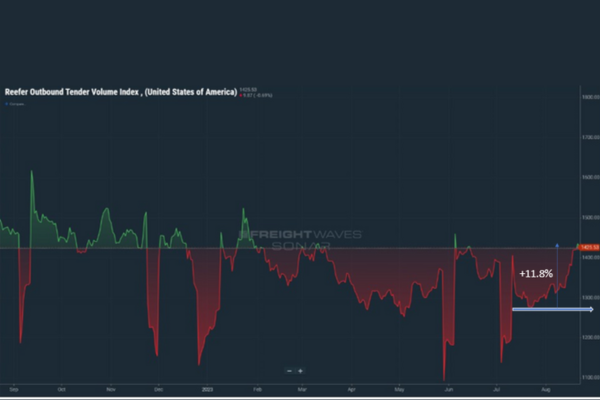Frozen and Refrigerated Cold Chain Insights
Welcome to The Cold Front, presented by RLS Logistics, the Cold Chain Experts! We proudly offer nationwide cold storage warehousing, ltl shipping, truckload freight brokerage and eCommerce fulfillment cold chain solutions. This month’s edition focuses on these topics for our August 2023 issue: cargo shipping, transportation market conditions, and warehouse rents. The Cold Front is a monthly summary highlighting pertinent cold chain storage market data in one concise location. These insights ensure that you have the data to make better decisions to fuel your growth. We hope you find this information useful! If you want data on your specific market, click the button below.
Cargo Shipping: Panama Canal Backlog
Historic drought conditions at the Panama Canal are wreaking havoc on the container shipping industry. According to a recent Food Logistics article, the United States accounts for 73% of the canal’s traffic. The timing is especially problematic as many retailers continue to focus on inventory reduction, and we are entering the busy season for food and beverage. Over 200 container ships are estimated to be in a traffic jam at the canal, some for over three weeks. Canal authorities have increased canal costs for the heaviest and largest ships, making it more costly to pass through the canal, which relies on rainwater from Gatun Lake for replenishment. The area is experiencing a yearlong drought that has lowered seawater in the canal. Canal authorities have additionally placed further restrictions on the number of daily bookings and reduced booking slots for large ships. Suppose water levels continue to decline as forecasted. In that case, the results will be higher shipping costs and a scramble to find alternative routes, which could cause another round of supply shortages and increased inflation. We will continue to monitor the conditions of the Panama Canal and its impact on the global supply chain.
Transportation Market Conditions: A Tale of Two Camps
As the US gets back to school and begins to ramp up for the holiday season, there are speculations that the soft freight market is starting to shift. Others, however, cite a continued decline in manufacturing output and excessive inventories that will extend the soft market into Q2 of 2024. So, who is right? Well, the answer just may be that both camps are correct. According to a recent article in the JOC, Chris Caplice, chief scientist at DAT Freight & Analytics, speculates that the spot freight market has hit bottom, which would mean that recovery is on the way. However, he also feels it could bounce on the bottom for the next two to three quarters before a significant recovery is realized. One thing is certain: according to FrieghtWaves Sonar, the reefer outbound tender volume index has increased by 11.8% since July 2023.
Additionally, the Truckstop.com 7-day reefer rate per mile increased by 9.1% during this period. An increase in freight volumes resulting in increased rates seems to point to a faster recovery. So why, then, do we have two conflicting camps? We speculate the difference is between overall freight volumes, including dry and bulk commodities, and temperature-controlled commodities. Our internal data suggests we are seeing a soft rebound in freight volumes. We see larger LTL temperature-controlled shipments converted into the truckload market starting to convert back to LTL. We also witness an increase in our reefer cost of hire-purchased transportation. It seems impossible to predict anything these days with confidence; however, we are in the camp of a shift in the soft freight market. The question remains: how long will it take for a complete recovery? We will continue to monitor external and internal data to provide you with our insights on the freight market.
Warehouse Leases: Rents Increase As Demand Decreases
In market dynamics, the traditional principles of supply and demand often steer the pricing and availability of commodities. However, the landscape of warehouse rents presents an intriguing exception. A recent analysis featured in the Wall Street Journal sheds light on this anomaly. Surprisingly, the second quarter of this year witnessed record-high rental pricing within the warehousing sector, with rates surging by a notable 16.1% compared to the same period the preceding year.
Nevertheless, this rental price surge unfolds even as industrial real estate vacancy rates have climbed to 4.1% year over year. Cushman & Wakefield, a recognized leader in commercial real estate, reports a substantial 36% decline in newly leased space. This decline can be attributed to a significant shift in consumer spending patterns, transitioning from goods to services, coupled with a strategic effort by major retailers to reduce excess inventory holdings.
The paradox of rising rent prices with diminishing demand can be explained by customers being more apt to sign longer lease terms. Prospective lessees increasingly opt for extended lease agreements, curbing the need for alternative space. Consequently, the quest for building more warehouse facilities to meet surging demand has subsided.
While projections indicate that rents will continue to rise, albeit at a moderate pace, it is essential to note that current interest rates curtail the appetite for owning new facilities. Considering these factors, the outlook for industrial rental rates remains robust and is not anticipated to decline in the foreseeable future.




